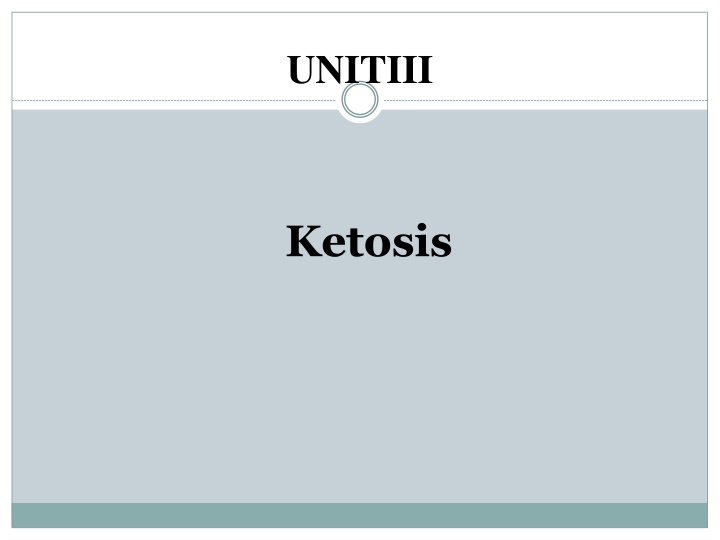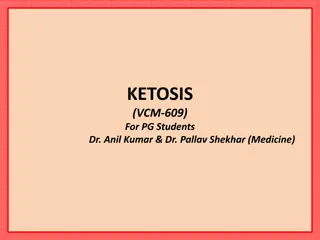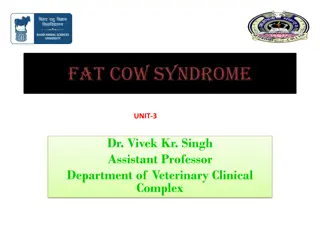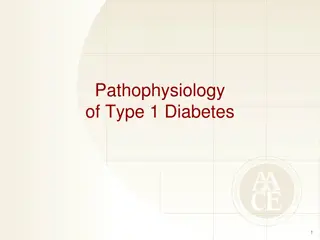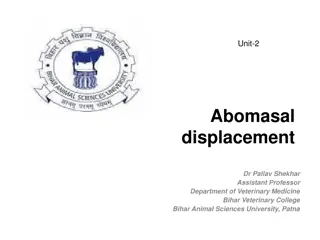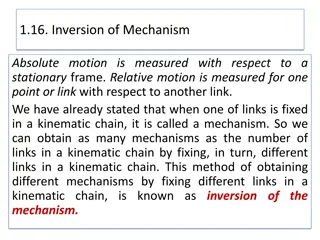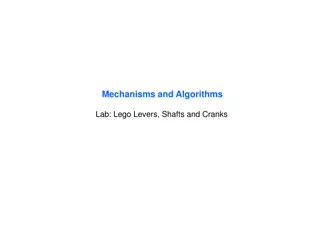Understanding Ketosis and Its Mechanisms
Ketosis is characterized by elevated ketone levels in the body, a normal response to low glucose levels. Explore the types of ketosis, biochemical alterations, and the liver's role in ketone body production.
Download Presentation

Please find below an Image/Link to download the presentation.
The content on the website is provided AS IS for your information and personal use only. It may not be sold, licensed, or shared on other websites without obtaining consent from the author.If you encounter any issues during the download, it is possible that the publisher has removed the file from their server.
You are allowed to download the files provided on this website for personal or commercial use, subject to the condition that they are used lawfully. All files are the property of their respective owners.
The content on the website is provided AS IS for your information and personal use only. It may not be sold, licensed, or shared on other websites without obtaining consent from the author.
E N D
Presentation Transcript
UNITIII Ketosis
Ketosis Ketosis simply means that ketones are present in body fluids in elevated concentrations Ketone hydroxybutyric acid and acetone bodies are acetoacetic acid, beta- Ketosis is frequently associated with ketoacidosis Ketosis is a normal response to low glucose availability Ketogenesis take pace in lever Aetyl CoAis precursor of ketone bodies
Mechanism of development Occurs restriction, prolonged exercise during fasting, starvation, carbohydrate Trace levels of ketones are always present in the blood Increase when blood glucose reserves are low Liver shifts from primarily metabolizing carbohydrates to metabolizing fatty acids
Mechanism of development.. When acids into acetyl-CoA, some acetyl-CoA molecules can then be converted into ketone bodies the liver rapidly metabolizes fatty These ketone bodies can function as an energy source The liver itself cannot utilize these molecules for energy, so the ketone bodies are released into the blood for use by peripheral tissues including the brain Acetyl-CoA can be metabolized through the TCA cycle in any cell
Mechanism of development.. It can also undergo ketogenesis in the mitochondria of liver cells When glucose availability is low, oxaloacetate is diverted away from the TCAcycle and is instead used to produce glucose via gluconeogenesis Excess ofAcetyl-CoA synthesize ketone bodies Uncontrolled production of ketones leads to keosis
Biochemical alteration Ketonemia- the presence of an abnormally high concentration of ketone bodies in the blood Hypoglycemia- decrease in blood glucose level Ketonuria- presence of ketone bodies in urine Rothera's test- Detection of ketone bodies in urine
Types of ketosis Alimentary ketosis Fasting Ketosis Diabetic Ketosis Ketosis Associated with Pregnancy and Lactation Bovine ketosis- Cattle Pregnancy toxemia- Sheep Postexercise Ketosis
Alimentary ketosis Alimentary ketosis occurs when cattle have been fed spoiled silage that contains excessive amounts of butyric acid Ketogenesis can occur from Volatie Fatty acid Propionate is the major gluconeogenic precursor and is not an important precursor of ketones Butyrate is converted to 3-hydroxybutyrate by the rumen epithelium Rumen epithelial cells possess high activities of butyryl- CoA synthetase, which can convert butyrate to butyryl- CoA
Fasting Ketosis During promote lipolysis fasting, hormonal changes occur that Plasma (hypoglycemia) glucose concentrations will decrease Low plasma insulin concentrations high plasma glucagon concentrations These concentrations in adipose cells, which leads to the activation of hormone sensitive lipase hormonal changes will increase cAMP Long chain fatty acid released from adipose tissue
Diabetic Ketosis More frequently in dogs and cats than other domestic species Diabetes whereas most other ketotic syndromes occurring in domestic animals are usually accompanied by normoglycemia or hypoglycemia is accompanied by hyperglycemia, The ketonemia in diabetes is due to increased lipolysis in adipose plus gluconeogenesis accelerated hepatic
Post exercise ketosis During exercise long chain fatty acid bodies is utilized by muscles Ketone bodies formed from long chain fatty acid is utilized by muscle Trained athlete have high activity of enzyme related to fatty acid and ketone bodies utilization After exercise ketone bodies is still synthesizing which leads to accumulation of ketone bodies (Ketosis)
